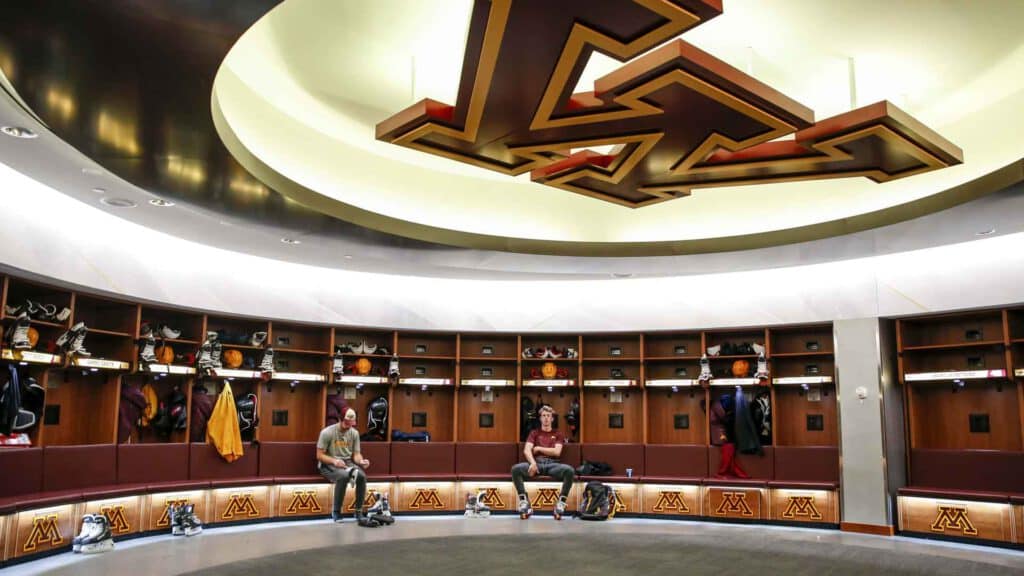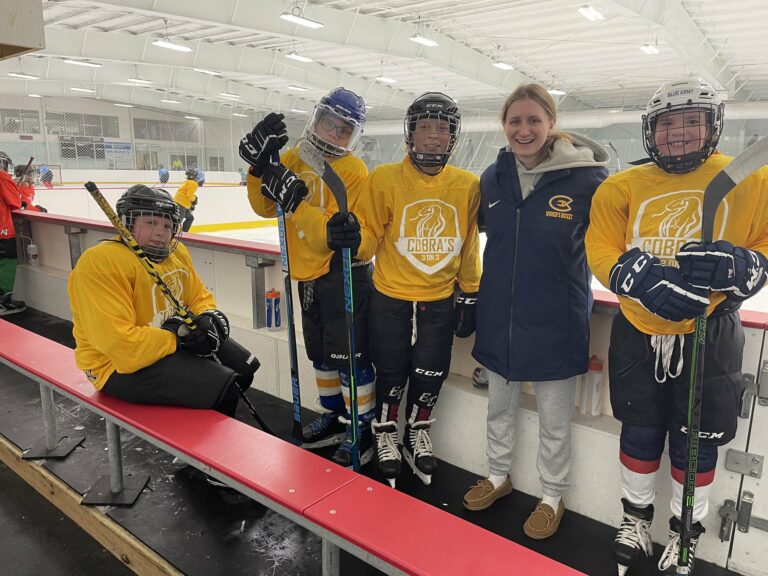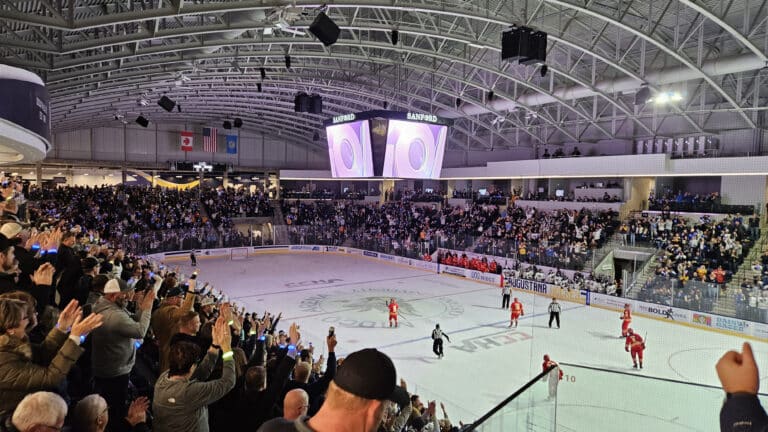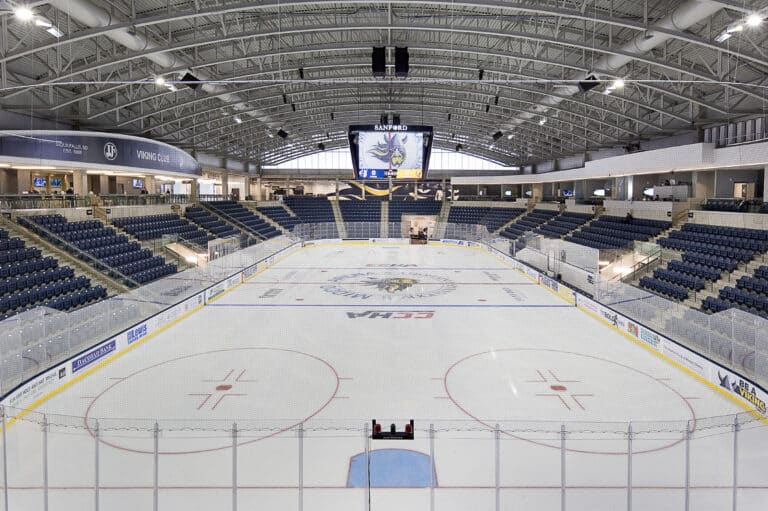A large-scale remodel of the Minnesota Gophers hockey locker room opened in 2016, with the team going to the oval room design that is popular among many modern college and NHL teams. Tyler Schank / The Rink Live
By Jess Myers
(Editor’s note: Over the last 70 years, the Minnesota Gophers have had two permanent hockey homes. In this three-part series, The Rink Live is taking a look at the past, present and future of the Gophers’ home rinks. In Part 3, we look at their current home rink after a quarter-century, and what the future may hold for this venue.)
MINNEAPOLIS — You can’t fault hockey teams of the early 1980s for wearing Cooperalls — that ugly combination of hockey pants and socks that made players look like they were skating in nylon track pants. At the time, most teams were doing it.
In a similar vein, the Minnesota Gophers were just following the style of that era in 1993, when they built the new Mariucci Arena with an Olympic-size ice sheet (200 feet long and 100 feet wide — 15 feet wider than the standard NHL playing surface). St. Cloud State and Alaska Anchorage had done it first. Minnesota State Mankato and New Hampshire opened new rinks with the big ice surfaces a few years later.
Issues of size, and sound
Today, nobody in college hockey is doing it. Berry Events Center at Northern Michigan opened with an Olympic-size ice sheet in 1999. There have been no more in the ensuing 20 years.
While the big ice sheet inside what’s now known as 3M Arena at Mariucci makes it unique, and can be a home ice advantage that often gets inside the heads of visiting teams, it’s the worst thing about the 26-year-old building for some. That was the impression Lou Nanne got when he first set foot in the then-new rink in 1993.
“It’s phenomenal, I just didn’t like the ice surface. Never have, never will. Way too big, and I’ve always thought that was a big mistake,” said Nanne, who was the Gophers’ captain in 1963, and has had a son and grandsons play in the program. “It magnifies mistakes. You’ve got to be a really good team to play effectively on a big ice surface, with passing.
“But more than that, it takes away your checking ability. You have to wait for somebody to hit them because they’re so far away.”
There have been major changes made to 3M Arena at Mariucci over the last quarter-century. Extra suites were added on the north side of the building. A new video scoreboard was installed. The players-only areas under the south stands were massively renovated in recent years.
And Ridder Arena, home of the Gopher women’s hockey program, was built next door in 2002 with a tunnel connecting the two facilities. But the big ice sheet has remained at 3M Arena. That lake-sized sheet of ice, and the still-bad acoustics, are among the biggest complaints you hear about the Gophers’ home rink these days.
“They’ve got to change the acoustics,” said Gophers radio broadcaster Frank Mazzocco. “If they want to play music, it shouldn’t have to be ear-splitting. It could be comfortably loud like it is at (Xcel Energy Center) or at Yost (Ice Arena at Michigan). I’m not an acoustic engineer, but use spray foam or whatever. They’ve got to fix the acoustics.”
Not a sound decision
The arena was built with metal across the ceiling, as was the National Hockey Center in St. Cloud.
“They put the metal roof on it on purpose because they wanted it to be loud. They didn’t care what the acoustics sounded like,” Gophers coach Bob Motzko said. “Now, that’s all the fans complain about is that you can’t hear anything. We’ve now all been to the new Vikings stadium and other new places where the acoustics and the visuals are perfect. We’re all spoiled group. So there are things like acoustics that we need to look at.”
READ: SCSU seeks funding for new refrigeration system at Brooks Center, could reduce rink sizes
And when St. Cloud State announced recently that they want $8.5 million in state dollars to replace their ice-making plants, they also talked about a reduction in the size of the Olympic ice sheets at the Herb Brooks National Hockey Center. Motzko thinks a similar change will eventually come to the Gophers’ rink, and calls Olympic-size ice sheets “a fad that went through.” Just like Cooperalls.
“There will be a day when we shrink our rink. But I don’t think it’s as big a deal,” Motzko said. “We’re still going to be a great skating program and we have a little extra width out there, but it will happen and I think it will enhance the fan experience too. It will be a little tighter, a little more physical and it will be great for hockey.”
Tickets on tap
The need for a better fan experience was underscored in March, when paltry crowds showed up for two home playoff games with Michigan, which were not included in the season ticket package. Average attendance has seen a steady decline for over the past five seasons.
In 2014-15, the rink was at 99.8 percent of capacity. Last season, that number was 79.4 percent. U of M athletic director Mark Coyle, in an interview with The Rink Live, said “it’s on us” to get more fans in the building, and announced a reduction in the cost of some season tickets. The school’s athletic department also offered discounts on thousands of tickets during a sale at the Minnesota State Fair, with seats to see Niagara and Penn State going for as little as $10.
It’s a sharp contrast from 26 years ago.
The new arena opened just a few months after the Minnesota North Stars left the state, meaning that Gophers hockey was the biggest on-ice show in the Twin Cities. With no NHL competition for ticket sales, the school was able to sell countless season tickets and club room memberships to corporate interests, which was a revenue boost.
The problem with that is that all too often those prime tickets, located between the blue lines, were purchased but not used and spent the weekend in a desk drawer somewhere in a downtown Minneapolis skyscraper.
Looking ahead
The new arenas in St. Cloud and Minneapolis opening within four years of each other kicked off a bit of an arms race in college hockey. The state’s other three schools — Minnesota State Mankato, Bemidji State and Minnesota Duluth — all moved into new arenas in the past 25 years. So did Denver, Colorado College, Nebraska Omaha, Wisconsin, North Dakota, Notre Dame and Miami (Ohio).
With competition to recruit talent that is more intense than ever, the Gophers are constantly looking to improve their home rink. In July, the school’s Board of Regents approved a renovation project affecting 11,000 square feet of space that will bring a new weight room, a remodeled office suite and a new ‘M’ Club alumni room. The hope is to start work before the end of 2019.
Even if the building boom means that 3M Arena at Mariucci is one of the older buildings in the region now, the efforts to keep it state-of-the-art are on-going.
“Frank Serratore nicknamed it the ‘Woogerdome’ all those years ago when it was built, and it’s still the mecca of college hockey all these years later,” Motzko said.





